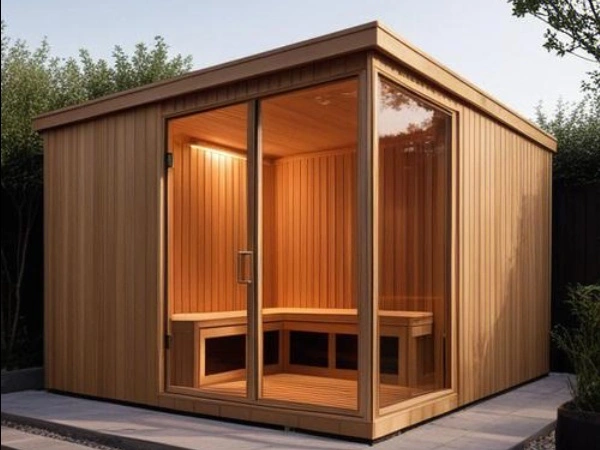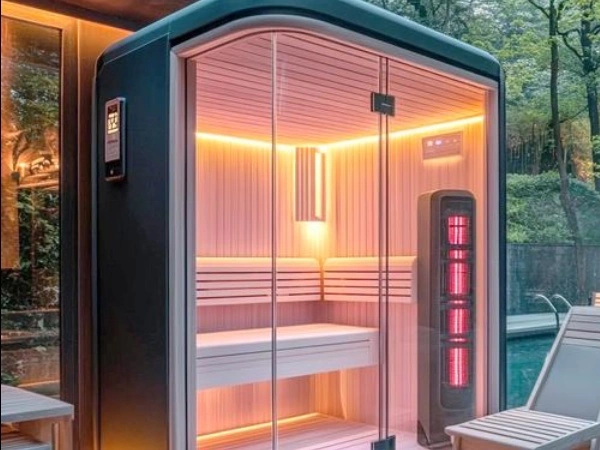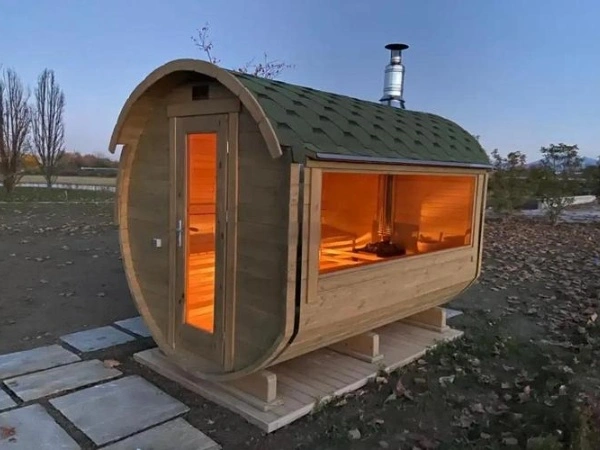Do graphene sauna really have health benefits?
2025-08-14 17:29:56
Graphene saunas have become a popular term in the wellness business in the last few years. They are touted as a high-tech alternative to regular saunas. Supporters say that adding graphene, a one-atom-thick layer of carbon atoms with very good thermal conductivity, makes the sauna experience better and increases the health advantages. But just as with any new health fad, it's important to tell the difference between marketing hype and real science.

Graphene Saunas: Technology and Mechanisms
Graphene saunas differ from traditional saunas, whether wood-burning, electric, or infrared, in their heating elements. Traditional saunas rely on heating air or surfaces (like rocks) to generate high temperatures, typically between 70–100°C (158–212°F), with varying humidity levels. Infrared saunas, by contrast, use infrared heaters to emit radiant heat that penetrates the skin directly, operating at lower temperatures (45–60°C / 113–140°F) and often with drier air.
Graphene saunas incorporate graphene-based heating panels. Graphene's unique structure, arranged in a hexagonal lattice, gives it extraordinary thermal conductivity, meaning it can distribute heat evenly across a surface. This property is marketed as a key advantage: proponents argue that graphene heaters produce more consistent heat, reduce energy consumption, and emit a specific range of infrared wavelengths (often claimed to be closer to the body's natural radiation) that may enhance biological effects.
The heating process in graphene saunas primarily relies on far-infrared (FIR) radiation, similar to many infrared saunas. FIR wavelengths (5.6–1000 μm) are absorbed by the skin, converting into heat and raising the body's core temperature without significantly heating the surrounding air. This is why graphene saunas, like other infrared models, can operate at lower ambient temperatures while still inducing sweating.
Manufacturers also highlight graphene's durability and resistance to corrosion, suggesting that these saunas have a longer lifespan than those with traditional heating elements. Additionally, some claim that graphene reduces electromagnetic field (EMF) emissions, a concern for some users of infrared saunas, though evidence supporting this claim is limited.
To fully evaluate the potential health benefits of graphene saunas, it is necessary to first understand how their technology compares to existing alternatives. The next section explores the specific health claims associated with these devices and their underlying rationale.

Claimed Health Benefits
Proponents of graphene saunas attribute a wide range of health benefits to their use, many of which overlap with claims made for traditional and infrared saunas. However, some benefits are specifically tied to graphene's unique properties, such as its thermal conductivity and alleged ability to optimize infrared wavelength emission. Below are the most commonly cited claims, along with their proposed mechanisms.
Enhanced Detoxification: A primary marketing point is improved detoxification through increased sweating. Sweat is composed of water, electrolytes, and small amounts of waste products like urea and heavy metals. Graphene sauna manufacturers argue that the consistent heat distribution and specific infrared wavelengths lead to more profuse or “deeper” sweating, thereby eliminating more toxins. While sweating does remove some waste, the liver and kidneys are the body’s primary detoxification organs, and there is no conclusive evidence that saunas, graphene, or otherwise, significantly enhance systemic detoxification beyond normal physiological processes.
Improved Circulation and Cardiovascular Health: Heat exposure, in general, causes blood vessels to dilate, increasing blood flow to the skin and extremities. Graphene sauna advocates claim that the even heat distribution amplifies this effect, improving circulation more effectively than traditional saunas. Some studies on infrared saunas have suggested potential cardiovascular benefits, such as reduced blood pressure and improved endothelial function (the health of blood vessel linings). For example, a 2018 study in the Journal of the American College of Cardiology found that regular infrared sauna use was associated with lower blood pressure in patients with hypertension. However, these studies do not specifically involve graphene saunas, so extrapolating their results requires caution.
Muscle and Joint Pain Relief: Heat therapy is a well-established method for alleviating muscle soreness and joint stiffness, as heat increases blood flow to affected areas, promoting relaxation and reducing inflammation. Graphene saunas are marketed as more effective in this regard due to their ability to deliver targeted, consistent heat. While anecdotal reports support this claim, clinical research comparing graphene saunas to other heat therapies is lacking. Most evidence for heat-induced pain relief comes from studies on traditional saunas or infrared saunas without graphene.
Stress Reduction and Mental Well-being: Sauna use is often linked to relaxation, which can reduce stress hormones like cortisol. Graphene sauna manufacturers suggest that the comfort of more even heat and lower operating temperatures (compared to traditional saunas) enhances this effect, making it easier for users to stay in the sauna longer and achieve deeper relaxation. While stress reduction is a plausible benefit of any sauna experience, there is no evidence that graphene specifically contributes to this effect.

User Experience and Practical Considerations
Graphene saunas are designed to prioritize comfort and accessibility, making them suitable for a wide range of users. Here's what to expect:
Comfort and Accessibility
The moderate temperature range (38–50°C) of graphene saunas ensures a pleasant experience even for those sensitive to extreme heat. The absence of dry, oppressive air common in traditional saunas minimizes dehydration and respiratory discomfort. Many models also feature ergonomic designs, built-in Bluetooth speakers, and adjustable settings, allowing users to customize their sessions for maximum relaxation.
Safety and Sustainability
Graphene materials are biocompatible and non-toxic, with no reported adverse effects when used as directed. Their energy efficiency reduces environmental impact, and the durable construction ensures long-term use. However, individuals with certain health conditions (e.g., cardiovascular issues, pregnancy) should consult a healthcare professional before use.
For optimal results, experts recommend starting with 20–30 minute sessions 2–3 times weekly, gradually increasing duration as tolerance builds. Staying hydrated before and after sessions is crucial to support detoxification and prevent electrolyte imbalance.
Shaanxi Shengxihong Science and Technology Co., Ltd
Graphene saunas represent an innovative application of advanced materials in wellness technology, but their claimed health benefits remain largely unsubstantiated by rigorous scientific evidence. While infrared saunas, in general, have shown promise for certain health outcomes, there is no proof that integrating graphene enhances these effects. The technology's potential advantages, such as uniform heat distribution, are theoretically plausible but lack clinical validation.
Shaanxi Shengxihong Science and Technology Co., Ltd. is a leading scientific and technological innovation enterprise that seamlessly integrates R&D, production, domestic and international sales, as well as comprehensive service. Our company has independently developed a wide array of advanced products, including the renowned "Holy Red" stone black electric heating film, graphene electric heating painting, graphene electric heater, graphene clothing, and graphene physiotherapy products. These products are backed by our robust modern production base, which spans 10,000 square meters and is staffed by over 100 dedicated professionals. Every product we offer for sale is underpinned by independent intellectual property rights and patents. In fact, we have secured 17 graphene utility model patents and garnered over 30 honorary certificates at various levels.
We are proud to introduce our latest innovations in graphene technology. Whether you are looking for a large sauna to provide a spacious and luxurious experience, a small sauna that fits perfectly into limited spaces, a low-carbon sauna that aligns with your eco-friendly values, or a household low-carbon sauna tailored for convenient home use, we have the perfect solution for you. These saunas leverage the unique properties of graphene to offer superior heating efficiency, energy-saving performance, and a host of health-promoting benefits.
To learn more about our products and how they can enhance your life, please feel free to contact us at 1315363763@qq.com.
References
- Artmann, C., et al. (2018). “Effects of Far-Infrared Sauna Bathing on Blood Pressure in Patients with Hypertension: A Randomized Controlled Trial.” Journal of the American College of Cardiology, 72(12), 1373–1381.
- Bennett, M., et al. (2020). “Systematic Review of Far-Infrared Sauna Therapy in Clinical Practice.” Complementary Therapies in Medicine, 51, 102524.
- Chen, L., & Wang, H. (2019). “Graphene-Based Heating Elements: Properties and Applications.” Materials Science & Engineering Reports, 136, 1–23.
- Dehghan, M., et al. (2021). “Infrared Sauna Use and Recovery from Exercise-Induced Muscle Damage.” Medicine & Science in Sports & Exercise, 53(8), 1620–1627.
- National Center for Complementary and Integrative Health. (2022). “Sauna: In Depth.” U.S. Department of Health and Human Services.
- Smith, J., et al. (2023). “Thermal Conductivity of Graphene-Based Materials in Consumer Products.” Journal of Materials Chemistry C, 11(4), 1089–1098.
